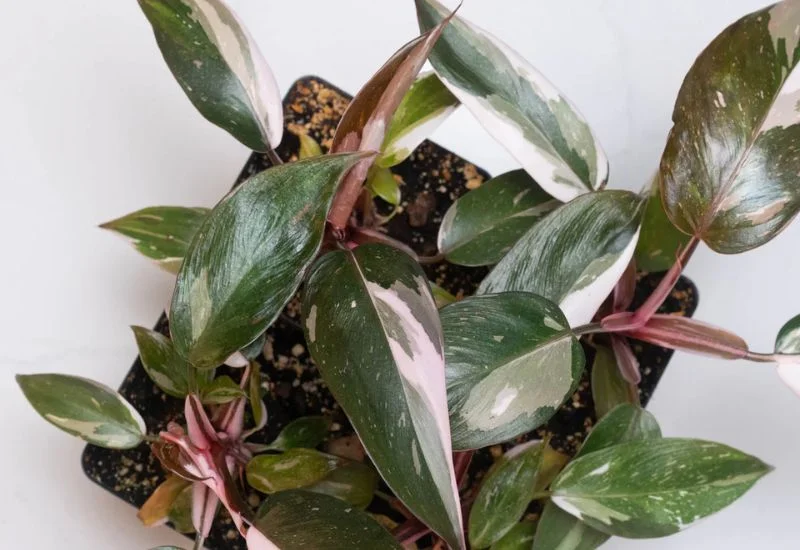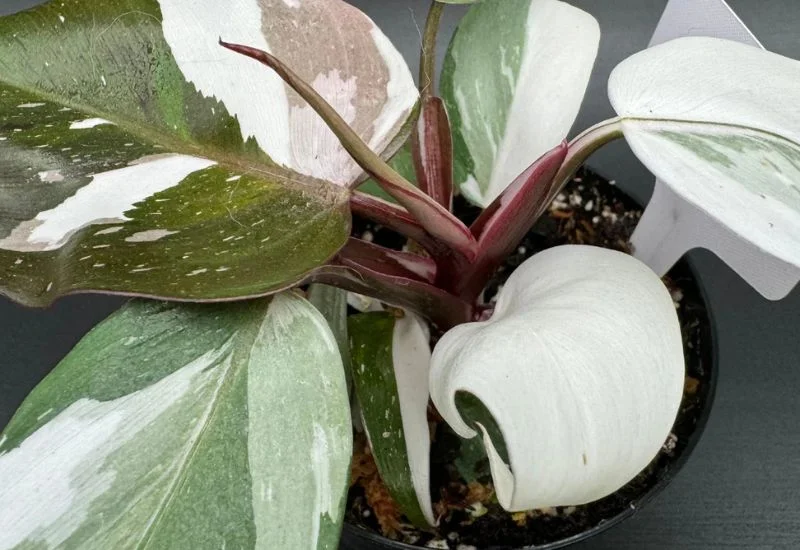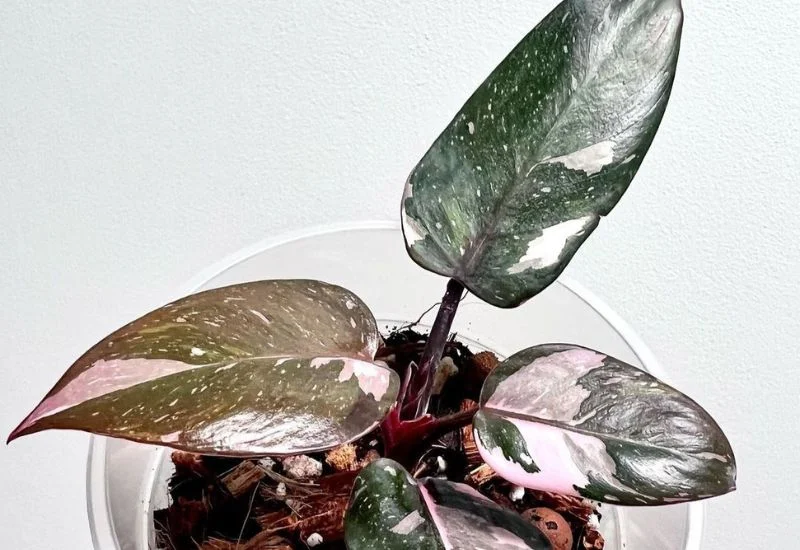In this blog post, you’re going to learn how to easily propagate and care for Philodendron Red Anderson.
This is a comprehensive guide covering reliable information about different aspects of this variety.
In this post, I’ll cover:
- Interesting Facts
- Propagation
- Repotting
- Care
- Similar Plants
- Solutions to Common Problems
So, if you are looking to propagate and care for Philodendron Red Anderson, this guide is for you.
Let’s jump right in!
Fun Facts
| Common Name | White Anderson, or Pink Anderson |
| Botanical Name | Philodendron erubescens ‘Red Anderson’ |
| Family | Araceae |
| Plant Type | Perennial |
| Fruit | No |
| Mature Size | The plant can grow up to 2 to 3 feet long and 1 to 2 inches thick. |
| Sun Exposure | Bright indirect sunlight |
| Soil Type | well-drained, moist soil |
| Soil pH | 5.5 to 6.5 |
| Native Area | Tropical rainforest in Central and South America |
| Toxic | Yes |
| Growth | Slow to moderate |
The beautiful variegation of the plant makes it a perfect houseplant. The plant can be placed outdoors and indoors. The philodendrons prefer warm and humid conditions to live.
The plant prefers well-drained soil with a pH of 5.5 to 6.5. The plant grows slowly to moderately and grows into a very compact size, which makes it perfect for home use. The leaves of the plant come in a very large heart shape. The plant has green color as a base and pink-red color variegation across the leaves.
The leaves of the plant can grow up to 6 to 10 inches long. The plant has a pale green spathe and white cream spadix. It is very rare for this plant to produce fruit indoors. The plant is mainly appreciated for its beauty rather than for flowering and fruiting.
Benefits

The plant is beautiful and offers several benefits as well. Here is a list of benefits when growing red Anderson philodendrons:
Aesthetic Appeal
The beautiful leaves of the plant and pink and red variegation make it a perfect plant to increase the aesthetic of your home. The plant will become the center of attention anywhere you place it.
Air Purification
The red Anderson philodendron also works as a natural air purifier. The plant absorbs harmful chemicals from the air, keeping the environment clean.
Low Maintenance
The low-maintenance plant needs watering in 7 to 10 days and indirect light to survive. The plant is the best choice for both experienced gardeners and novices.
Compact Growth
The plant has very compact growth, which makes it a perfect indoor plant. You can place it anywhere in your home.
Mood Enhancement
The plants can enhance mood and help reduce stress. Placing the plant at your workplace can increase your productivity.
Rare and Unique
The plant is very rare, which makes it perfect for addition to your plant collection.
Propagation

The propagation of the red Anderson philodendron can be done through stem cutting. Take a healthy stem with at least 3 to 4 leaves. Only use sterilized equipment for cutting. Remove the lower leaves from the stem. After cutting the stem, place it into the rooting hormone. While this step is optional, it can enhance the plant’s growth. Place the stem into the water. Change the water as needed to prevent infection. In some weeks, the roots will start to develop. Once the roots are 1 inch long, place the cutting in a pot of well-drained soil.
Repotting
The plant needs repotting every 1 to 2 years. You will notice when the plant needs repotting. The roots become bound, and you might see them growing out of the drainage hole of the pot, indicating less available soil. Bring a pot 3 to 4 inches bigger than the previous one.
Care
Here is the list of points you need to keep in consideration while taking care of your red Anderson philodendron:
Pruning
Pruning is an important step in controlling the size and shape of the plant. The plant does not require pruning so often, but you can trim any yellow or brown leaves. You can also trim your plant to manage the shape and size.
Soil
The plant needs well-drained and moist soil that has the ability to hold the needed moisture for the plant. Avoid overwatering and check the drainage hole of the pot. The unwanted stay of water can lead to the root rot. You can use a potting mix or make your soil by adding perlite and orchid bark.
Pot
The ceramic pot is recommended because it holds the moisture for the plant and provides breathing space for roots too.
Water
Water your plant as per its needs instead of watering on a set schedule. When the top inch of the soil starts to dry, water the plant. Do not wait for the soil to dry completely; it can impact the health of your plant. You can check the soil with the help of your fingers.
Light

The plants need bright indirect light to thrive. Too much exposure or direct sunlight can scorch the plant’s leaves. The plant can survive in less light, but that can reduce the growth of the plant.
Fertilizer
The plant needs fertilizer for perfect growth. Use fertilizer for only half of its strength. Do not apply fertilizer directly to the dry soil; it can burn the plant’s roots. Water the plant first and apply fertilizer once a month. Stop using fertilizers in a month when the temperature starts to fall, such as in winter and fall.
Placement
Place your plant in the east or north-facing window that is perfect for bright indirect sunlight. If there is no perfect spot, you can draw sheer curtains to protect the plant from direct sunlight.
Temperature and humidity
The plant prefers warm and humid conditions to thrive. The preferred temperature for the red Anderson philodendron is 65 °F to 80 °F. Temperatures below 60 °F can cause your plant to droop. The plant enjoys more humid conditions but does well in normal household humid conditions. If the environment of the house is too dry, you can increase the humidity near the plant. Place a humidifier or tray filled with pebbles and water.
Common Problems

Here is the list of common problems that every plant faces:
Pests
Cause
Philodendrons naturally attract insects and bugs. The most common insects are spider mites, scales, mealybugs, and fungus ants, which start to consume your plant.
Solution
Inspect your plant for bugs or insects. If you find any, wipe them off. Clean the leaves of the plant with a damp cloth. You can also use neem oil or solution spray to kill the bugs.
Fungal Diseases
Root rot
Cause
The main reason for the root rot is the overwatering and poor drainage system of the pot. The unwanted stay of water causes the root to rot.
Solution
Avoid overwatering. Water your plant when the soil starts to dry, and make sure the pot drainage hole is working properly.
Leaf spot
Cause
The spot on the leaves can be due to more moisture and less air circulation.
Solution
Increase the air circulation around the plant and reduce the humidity if necessary.
Powdery Mildew
Cause
It’s a white powdery substance on the leaves of the plant due to poor air circulation and a more humid area.
Solution
Clean the leaves of the plant with a damp cloth and increase the airflow near the plant.
Anthracnose
Cause
This disease caused small dark lesions on the leaves which led to tissue death. The reason can be more moisture on the leaves of the plant and poor air circulation.
Solution
Increase airflow near the plant, avoid overwatering, and give your plant copper-based fungicide.
Brown Tips
Cause
The low humidity around the plant or less watering can be the reason for brown tips and leaves.
Solution
Place your plant in a more humid area or increase the humidity by placing a humidifier. Water your plant as per its need.
Curling Leaves
Cause
There can be several reasons for curling leaves, such as overwatering, underwatering, lower humidity, pests, and too much light, which can lead to curling leaves.
Solution
Before taking any action, inspect the plant’s environment carefully to find the real culprit and then take action accordingly.
Yellow leaves
Cause
Overwatering and insufficient exposure to sunlight can cause yellow leaves. Less watering and more exposure to the sun can reverse this.
Solution
Avoid overwatering and place your plant in indirect bright light. Overwatering can cause root rot, and more exposure to the sun can burn the leaves.
Ready to Grab a Philodendron Red Anderson to add beauty to your home garden?
All the above information is reliable, and you’ll see outstanding results if you want to grow or care for this plant.
